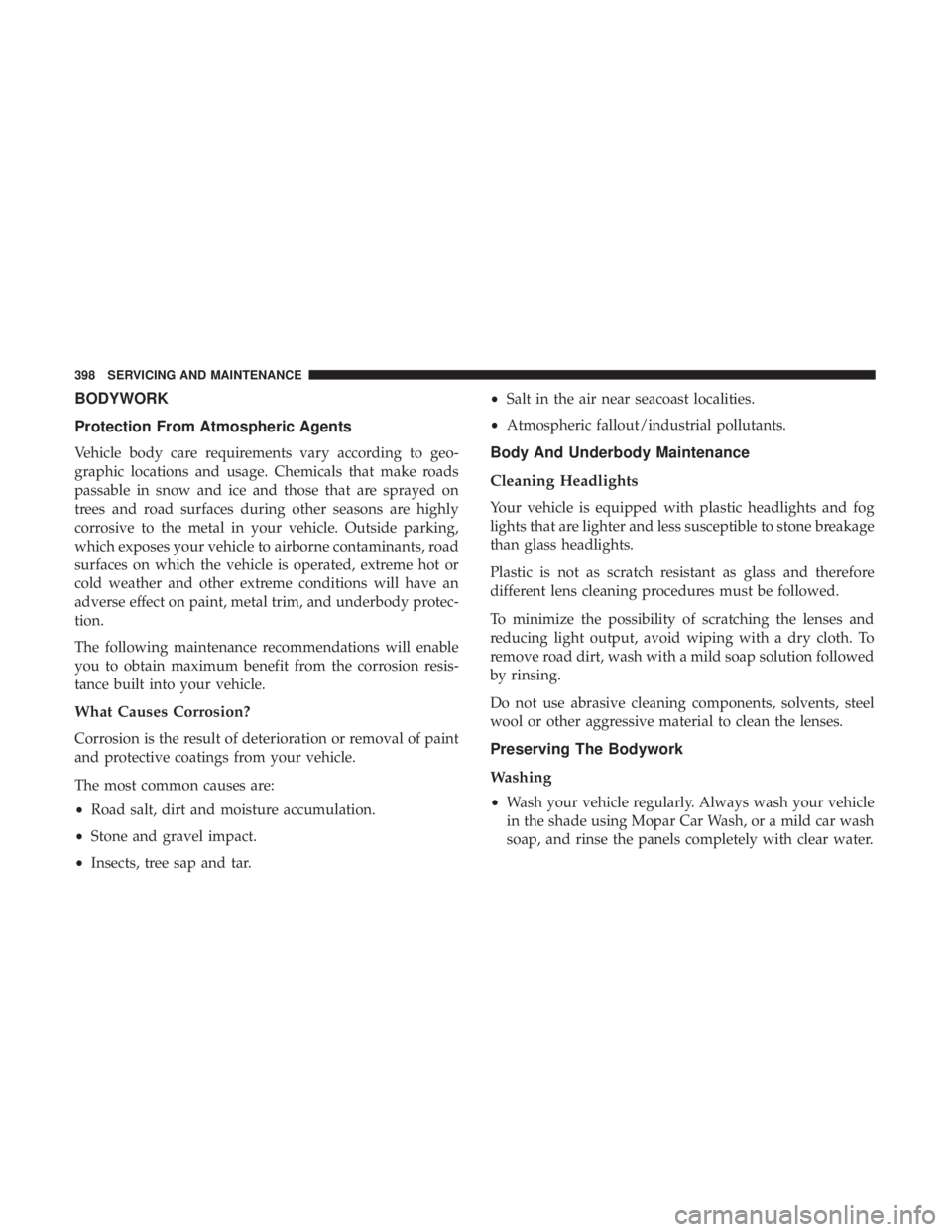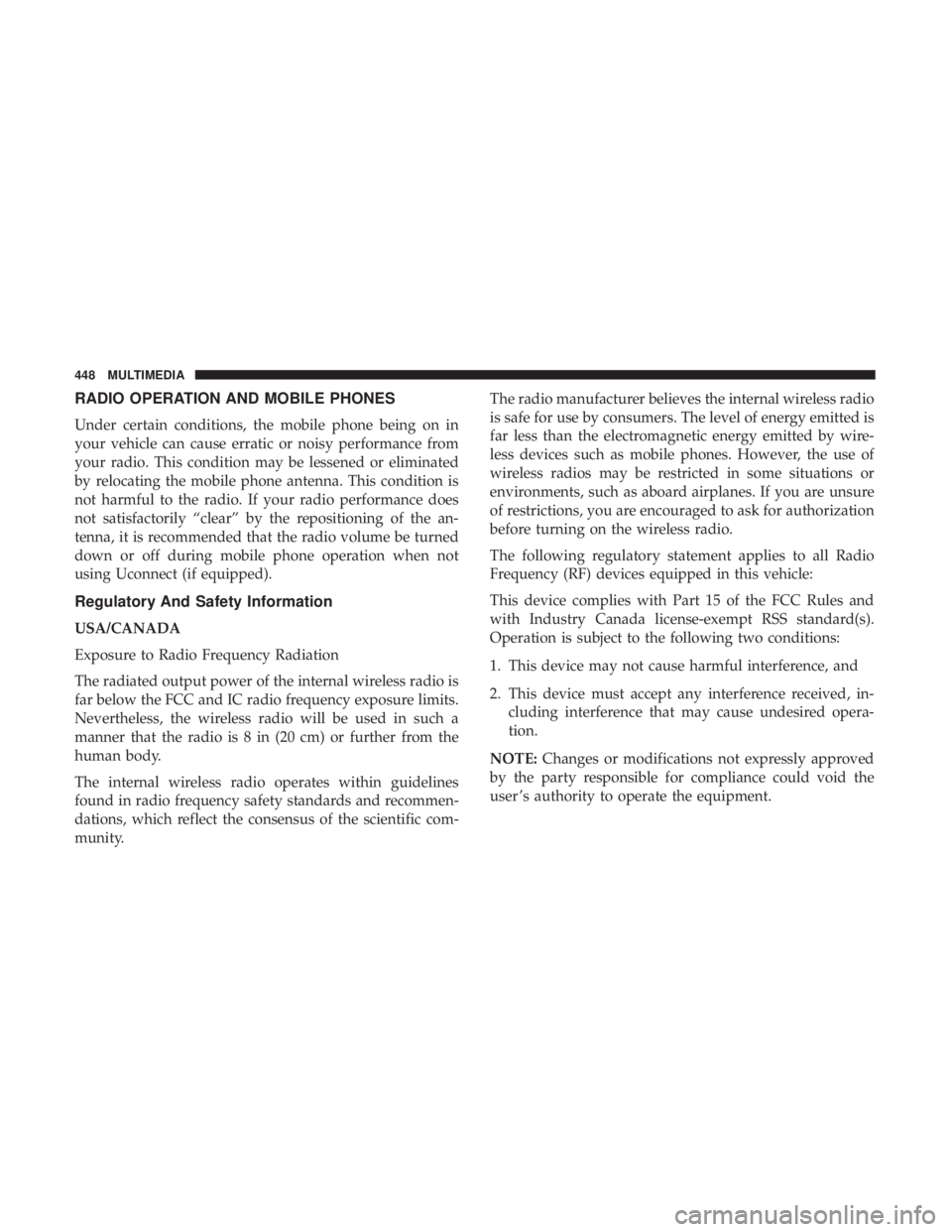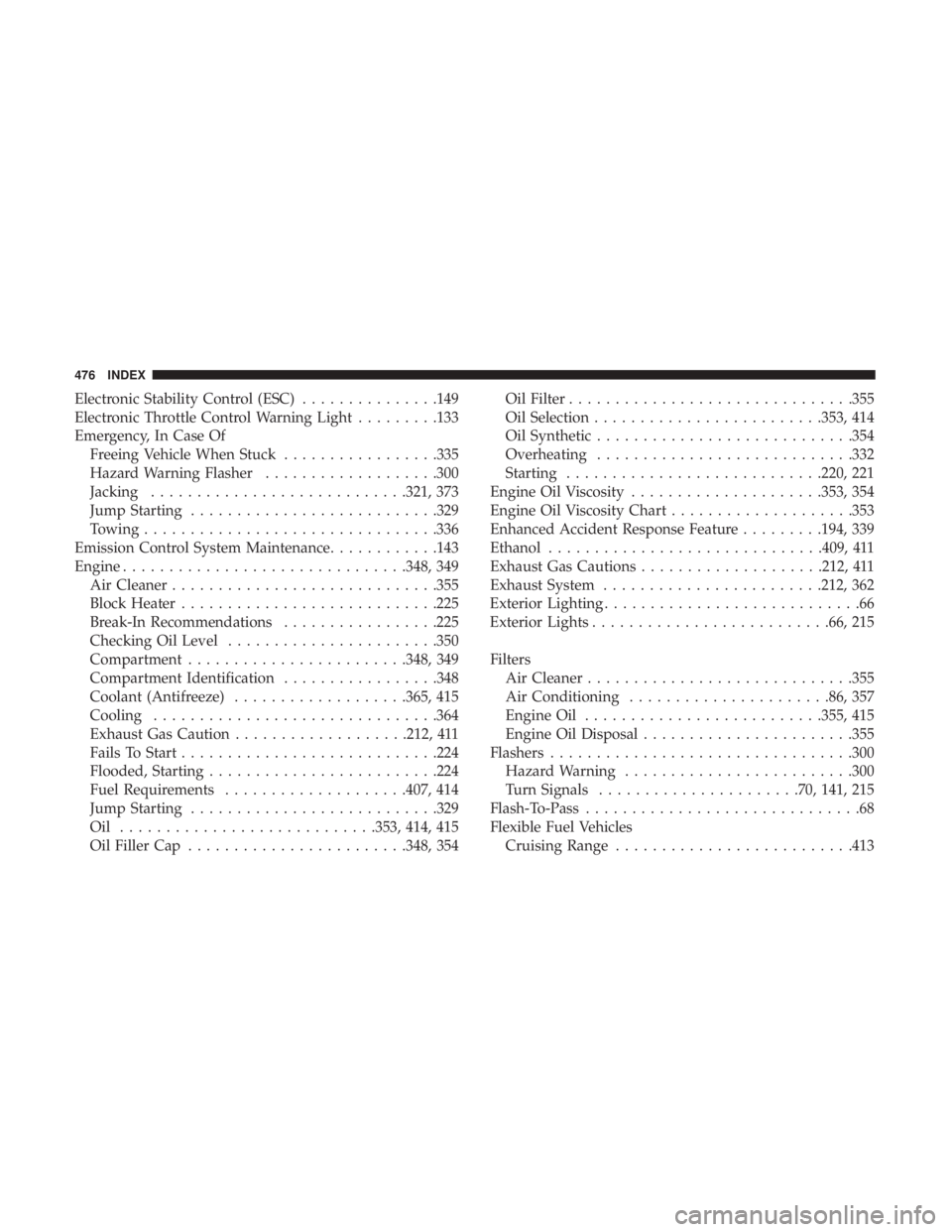2019 CHRYSLER 300 air condition
[x] Cancel search: air conditionPage 400 of 492

BODYWORK
Protection From Atmospheric Agents
Vehicle body care requirements vary according to geo-
graphic locations and usage. Chemicals that make roads
passable in snow and ice and those that are sprayed on
trees and road surfaces during other seasons are highly
corrosive to the metal in your vehicle. Outside parking,
which exposes your vehicle to airborne contaminants, road
surfaces on which the vehicle is operated, extreme hot or
cold weather and other extreme conditions will have an
adverse effect on paint, metal trim, and underbody protec-
tion.
The following maintenance recommendations will enable
you to obtain maximum benefit from the corrosion resis-
tance built into your vehicle.
What Causes Corrosion?
Corrosion is the result of deterioration or removal of paint
and protective coatings from your vehicle.
The most common causes are:
•Road salt, dirt and moisture accumulation.
• Stone and gravel impact.
• Insects, tree sap and tar. •
Salt in the air near seacoast localities.
• Atmospheric fallout/industrial pollutants.
Body And Underbody Maintenance
Cleaning Headlights
Your vehicle is equipped with plastic headlights and fog
lights that are lighter and less susceptible to stone breakage
than glass headlights.
Plastic is not as scratch resistant as glass and therefore
different lens cleaning procedures must be followed.
To minimize the possibility of scratching the lenses and
reducing light output, avoid wiping with a dry cloth. To
remove road dirt, wash with a mild soap solution followed
by rinsing.
Do not use abrasive cleaning components, solvents, steel
wool or other aggressive material to clean the lenses.
Preserving The Bodywork
Washing
•Wash your vehicle regularly. Always wash your vehicle
in the shade using Mopar Car Wash, or a mild car wash
soap, and rinse the panels completely with clear water.
398 SERVICING AND MAINTENANCE
Page 450 of 492

RADIO OPERATION AND MOBILE PHONES
Under certain conditions, the mobile phone being on in
your vehicle can cause erratic or noisy performance from
your radio. This condition may be lessened or eliminated
by relocating the mobile phone antenna. This condition is
not harmful to the radio. If your radio performance does
not satisfactorily “clear” by the repositioning of the an-
tenna, it is recommended that the radio volume be turned
down or off during mobile phone operation when not
using Uconnect (if equipped).
Regulatory And Safety Information
USA/CANADA
Exposure to Radio Frequency Radiation
The radiated output power of the internal wireless radio is
far below the FCC and IC radio frequency exposure limits.
Nevertheless, the wireless radio will be used in such a
manner that the radio is 8 in (20 cm) or further from the
human body.
The internal wireless radio operates within guidelines
found in radio frequency safety standards and recommen-
dations, which reflect the consensus of the scientific com-
munity.The radio manufacturer believes the internal wireless radio
is safe for use by consumers. The level of energy emitted is
far less than the electromagnetic energy emitted by wire-
less devices such as mobile phones. However, the use of
wireless radios may be restricted in some situations or
environments, such as aboard airplanes. If you are unsure
of restrictions, you are encouraged to ask for authorization
before turning on the wireless radio.
The following regulatory statement applies to all Radio
Frequency (RF) devices equipped in this vehicle:
This device complies with Part 15 of the FCC Rules and
with Industry Canada license-exempt RSS standard(s).
Operation is subject to the following two conditions:
1. This device may not cause harmful interference, and
2. This device must accept any interference received, in-
cluding interference that may cause undesired opera-
tion.
NOTE: Changes or modifications not expressly approved
by the party responsible for compliance could void the
user ’s authority to operate the equipment.
448 MULTIMEDIA
Page 474 of 492

About Your Brakes........................ .405
Adaptive Cruise Control (ACC) (Cruise Control) . . . .244
Adding Engine Coolant (Antifreeze) .............366
Adding Fuel ............................. .281
Adding Washing Fluid ...................... .350
Additives, Fuel ........................... .408
Adjust Forward ................................47
Rearward ...............................47
AirBag ................................ .186
Advance Front Air Bag ....................186
Air Bag Operation ....................... .188
Air Bag Warning Light .....................184
Driver Knee Air Bag ..................... .189
Enhanced Accident Response .............194, 339
Event Data Recorder (EDR) .................339
FrontAirBag .......................... .186
If Deployment Occurs .....................193
Knee Impact Bolsters ..................... .188
Maintaining Your Air Bag System .............196
Maintenance ........................... .196
Redundant Air Bag Warning Light ............185
Side Air Bags .......................... .189
Transporting Pets ....................... .212
Air Bag Light ...................... .131, 184, 213Air Cleaner, Engine (Engine Air Cleaner Filter)
......355
Air Conditioner Maintenance ..................356
Air Conditioner Refrigerant ...................356
Air Conditioner System ....................79, 356
Air Conditioning ............................84
Air Conditioning Filter ....................86, 357
Air Conditioning, Operating Tips ................85
Air Filter ............................... .355
Air Pressure Tires................................. .384
Alarm Arm The System ...................... .35, 37
Panic ..................................22
Rearm The System ........................37
Security Alarm....................... .35,
135
Alarm System Security Alarm ...........................35
All Wheel Drive Towing ............................... .338
All Wheel Drive (AWD) ..................... .372
Alterations/Modifications Vehicle .................................5
Android Auto ............................ .461
Antifreeze (Engine Coolant) ................365, 414
Disposal .............................. .367
472 INDEX
Page 478 of 492

Electronic Stability Control (ESC)...............149
Electronic Throttle Control Warning Light .........133
Emergency, In Case Of Freeing Vehicle When Stuck .................335
Hazard Warning Flasher ...................300
Jacking ........................... .321, 373
Jump Starting .......................... .329
Towing ............................... .336
Emission Control System Maintenance ............143
Engine .............................. .348, 349
Air Cleaner ............................ .355
Block Heater ........................... .225
Break-In Recommendations .................225
Checking Oil Level ...................... .350
Compartment ....................... .348, 349
Compartment Identification .................348
Coolant (Antifreeze) ...................365, 415
Cooling .............................. .364
Exhaust Gas Caution ...................212, 411
Fails To Start ........................... .224
Flooded, Starting ........................ .224
Fuel Requirements ....................407, 414
Jump Starting .......................... .329
Oil ........................... .353, 414, 415
Oil Filler Cap ....................... .348, 354Oil Filter
.............................. .355
Oil Selection ........................ .353, 414
Oil Synthetic ........................... .354
Overheating ........................... .332
Starting ........................... .220, 221
Engine Oil Viscosity .....................353, 354
Engine Oil Viscosity Chart ....................353
Enhanced Accident Response Feature .........194, 339
Ethanol ............................. .409, 411
Exhaust Gas Cautions ................... .212, 411
Exhaust
System ....................... .212, 362
Exterior Lighting ............................66
Exterior Lights ......................... .66, 215
Filters Air Cleaner ............................ .355
Air Conditioning ..................... .86, 357
Engine Oil ......................... .355, 415
Engine Oil Disposal ...................... .355
Flashers ................................ .300
Hazard Warning ........................ .300
Turn Signals ..................... .70, 141, 215
Flash-To-Pass ..............................68
Flexible Fuel Vehicles Cruising Range ......................... .413
476 INDEX